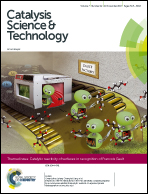Highly active Au/δ-MoC and Au/β-Mo2C catalysts for the low-temperature water gas shift reaction: effects of the carbide metal/carbon ratio on the catalyst performance†
Abstract
The water gas shift (WGS) reaction catalyzed by orthorhombic β-Mo2C and cubic δ-MoC surfaces with and without Au clusters supported thereon has been studied by means of a combination of sophisticated experiments and state-of-the-art computational modeling. Experiments evidence the importance of the metal/carbon ratio on the performance of these systems, where Au/δ-MoC is presented as a suitable catalyst for WGS at low temperatures owing to its high activity, selectivity (only CO2 and H2 are detected), and stability (oxycarbides are not observed). Periodic density functional theory-based calculations show that the supported Au clusters and the Au/δ-MoC interface do not take part directly in water dissociation but their presence is crucial to switch the reaction mechanism, drastically decreasing the effect of the reverse WGS reaction and favoring the WGS products desorption, thus leading to an increase in CO2 and H2 production. The present results clearly display the importance of the Mo/C ratio and the synergy with the admetal clusters in tuning the activity and selectivity of the carbide substrate.

- This article is part of the themed collection: Catalytic reactivity of surfaces: in recognition of François Gault


 Please wait while we load your content...
Please wait while we load your content...